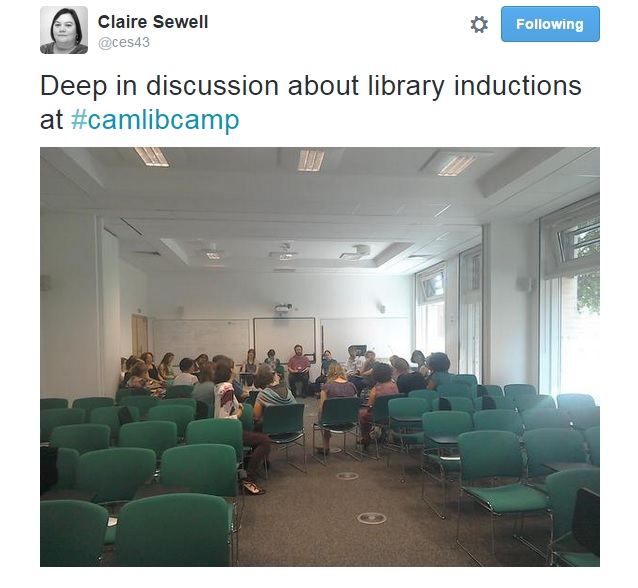
A few weeks ago I attended LibCamp; an Unconference for librarians at Cambridge University. What is an Unconference? Well think of the way many of the ASW’s quick-fire sessions worked, but then extend each session up to 45 mins, and you’ve got an idea of the way an Unconference works. Any attendee can suggest a suitable topic, topics are arranged into groups, and you then choose which discussions you wish to attend. The suggester will usually steer the group, but the group is discussion-based with anyone free to join in with tips, ideas, comments and queries whenever they wish. If you feel the group is not for you, you’re free to walk away and join another group at any point.
I thoroughly enjoyed my first Unconference. Major plus-point was that the groupwork and informal setting made it much easier for even the shyest librarians to join in; and – perhaps because of the unusual structure of libraries within Cambridge University – we have over 100 of them! – it was still a great opportunity to meet other librarians, and look at professional life from a different viewpoint.
The session that really got me thinking was one about induction courses. This may have been because I had been mulling the idea over with some colleagues earlier that week. What makes the perfect induction course? How do you introduce your new readers to the goodies that you have in store for them without overloading them with information? Is giving them all the information at once the way to go, or should you go for the drip-feed approach? Is earlier better when supplying information, or should you wait until your readers need you or is that too late? And how do you get around the “I don’t want to ask, because I’m going to look stupid” mindset (as though the Scary Librarian tag isn’t sufficiently off-putting).
There were many ideas that came up at LibCamp, some created from necessity but proving to be surprisingly popular (thanks SPS!), many were innovative. Staff produced videos, they provided library packs to be issued with welcome packs, they sent emails introducing themselves, they ran introductory online sessions with hands on / meet the librarians practical sessions in the Lent (Spring) term overcoming the problem of too much too soon. Some provided small incentives to encourage new readers to attend tours or fill in surveys (chocolate and free cuppas seemed to be especially popular, while one library swore by beer mats with library logos), while others went for a more traditional approach.
The Music Department has tried a range of different approaches – from the standard showing people around and giving them a quick guide to our catalogues, to blog posts about the intricacies (and oddities!) of the system, Powerpoint presentations on particular problem areas, behind the scenes tours (both popular and a great way to get to know your readers better), leaflets and extended talks. But I do feel that often the information, especially at the start of term, is just wafting over our readers’ heads. Hopefully they’re looking enthused and interested, but does this mean they’ve actually taken on board what you’ve said, or are they just dazed from all the information that’s been thrown at them?
So what do IAMLites do? Do you have a tried and tested method for introducing readers to your collections that really seems to work? Is little but often the best approach, or should you just go for the wow factor? This isn’t just a question for academic librarians either, what do public libraries do to help their readers find their way around? What have you done that has worked, and….perhaps just as importantly, were there any ideas that seemed a good idea at the time, but……
Coincidentally a few days after LibCamp I was deleting a load of old emails and came across an email from Almut Boehme at NLS. Noticing that there was a video link at the foot of her email, I was delighted to find an introduction to the music collections in the National Library of Scotland. An inspiration for all of us, perhaps?